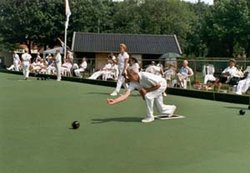Bowls
|
|
Bowls (or Lawn Bowls) is a precision sport where the goal is to roll slightly radially asymmetrical balls (called bowls) closer to a smaller white ball (the "jack") than one's opponent is able to do. It is related to bocce and pétanque.
The game is usually played on a large, rectangular precisely levelled and manicured grass surface known as a bowling green, but an indoor variation on synthetic grass is also played. In the simplest competition, singles, one of the two opponents begins a segment of the competition (in bowling parlance, an "end"), by rolling a white ball (the jack) along the green. Once it has come to rest, the players take turns to roll slightly larger and unevenly weighted bowls from a fixed mat towards the jack. After each competitor has used up their allocated number of bowls (it varies depending on the specific competition), the distance of the closest bowls from the jack is determined (the jack may have been moved from being hit by various bowls) and points are awarded for each bowl a competitor has closer than the opponent's nearest to the jack - for instance, if a competitor has bowled two balls closer to the jack than their competitor's nearest, they are awarded two points. The process is then repeated for the next end. If the jack is knocked off the playing arena by a bowl, the end is declared "dead" and no points are awarded.
Scoring systems vary from competition to competition, with some competitions being the first to a specified number of points (usually 21), while some award wins to the highest-scoring bowler after a specified number of ends. Finally, some competitions use a "set" scoring system, with the first to seven points awarded a set in a best-of-five set match. As well as singles competition, there are competitions for two, three and four-player teams. In these, teams take turns to bowl, with each player within a team bowling all their bowls, then handing over to the next player.
Bowls are designed to travel a curved path, referred to as bias. Originally bias was produced by inserting weights to one side and some players think that this is still done today. This is no longer permitted by the rules and bias is now produced entirely by the shape of the bowl. Regulations determine minimum and maximum curvature characteristics allowed, but within these rules bowlers can and do choose bowls to suit their own preference. They were originally made from lignum vitae (a dense wood giving rise to the term 'woods' for bowls) but are now more typically made of a hard plastic composite material, coloured black (with markings to determine which bowl belongs to each competitor), and by regulations have a diameter of about 15 centimetres.
When bowling, competitors have a choice of three different basic types of bowls. For a right-handed bowler, "forehand draw" is initially aimed to the right of the jack, and curves back to the left. A "backhand draw" curves the opposite way. In both cases, the bowl is weighted to stop on the green, usually (unless tactics demand otherwise) as close to the jack as possible. A "drive" involves bowling with considerable force with the aim of knocking either the jack or a bowl (usually the opponents) backwards, possibly off the playing arena - with the drive's speed, there is virtually no noticeable curve on the shot.
Particularly in teams competition where there can be large numbers of bowls on the green by the conclusion of the end, bowls involves complex tactics, where teams with the closest bowl will often make their subsequent shots not with the goal of placing the bowl near the jack's present position, but in positions to make it difficult for opponents to place a ball close to the jack, or to places the jack might be deflected to if the opponent attempts to move it.
Bowls is popular in the United Kingdom, Australia, New Zealand, and parts of the United States. Because of its relaxed pace and comparatively light physical demands, it is a popular participant sport, particularly for the elderly. However, there is a considerable professional competition dominated by younger men and women.
England's most famous bowler is, of course, Sir Francis Drake, who, in 1588, is said to have completed his game of bowls on Plymouth Hoe before setting sail to defeat the Spanish Armada.
Crown green bowls is a variant of lawn bowls played in the north of England, in Wales, and on the Isle of Man. It is played on a lawn from 30 to 60 yards (27 to 55 m) square. The centre of the lawn is 8 to 18 inches (200 to 450 mm) higher than its edges.fr:Bowls nl:Bowls sv:Bowls

